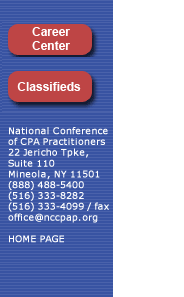

| |
|
|
|
|
|
|
|
|
|
|
|
|
|

July 2004
MEMBERS’
CORNER
BY STANLEY TEPPER, CPA, MBA
Gift Tax Returns – When making a gift that does not exceed the $11,000 gift tax exclusion, a gift tax return may not need to be filed. However, if the gift tax is real estate, shares in a private business or other types of gifts valued under the limit, it may be wise to file. By documenting the gift and establishing its value, you may have some protection should the IRS challenge the gift’s value in the future. With gifts such as real estate and shares, where the value could go up with a turn in the economy, an IRS agent might think that the gift was worth more at the time it was given. And, the IRS does have a 3-year window in which it can challenge the gift’s value. But, after that they can do nothing. If no returns are filed, no time limit exists.
Elder Law Exchange – The following two articlesappeared in a recent newsletter published by the law firm of Lamson & Petroff (212) 447-8690.
Terminating a Residential Lease Without Penalty- New York State law allows for the termination of a residential lease by a senior citizen moving to a residence of a family member, senior–citizen housing, an assisted-living-facility or a nursing home. Who iseligible?Any lessee or tenant who is age sixty-two years or older, or who will attain such age during the term of the lease or rental agreement, or the spouse of such person residing with him or her. How is the lease terminated? If the tenant can move into one of the specified facilities, he or she must terminate the lease in writing no earlier than thirty days after the date on which the next rental payment (after the notice is delivered) is due and payable. The written notice must include documentation of admission or pending admission to one of the facilities mentioned above. For example: Mail the notice on May 5; notice received on May 10; next rental payment due on June 1; termination is effective on July 1.
Revised Health Care Proxy – Last year New York State Department of Health released a revised health-care proxy form, which individuals may use to appoint a health-care agent. The form was revised primarily to include space for individuals to note instructions about organ donation. But the Department of Health also used the occasion to update and revise the
instructions and frequently asked questions that have long accompanied the form. For example, paragraph (4) of the form now expressly notes that an agent can make decisions about artificial nutrition and hydration if the principal’s wishes about such treatments are “reasonably known” to the agent, whether or not those wishes are written on the form. This state-approved form is available at http://www.health.state.ny.us . The approved proxy form is optional. Other versions that include the statutorily required elements as well as earlier approved health-care proxies remain valid.
Legally Searching Employees’ e-mail - The May-June 2004 newsletter published by Franklin, Gringer & Cohen, P.C. Labor Attorneys, devoted one article to employees’ e-mail. (The firm has in the past lectured our chapter).
The Electronic Communications Privacy Act (ECPA) is probably best known for barring the unauthorized wiretapping of telephone conversations. But Title I also bars intercepting
e-mail messages, defined as “the aural or other acquisition of the contents of any wire, electronic, or oral communication.” Title II of the ECPA creates civil liability for anyone who ‘intentionally :
1. Accesses without authorization a facility through which an electronic communication services is provided, or
2. Exceeds an authorization to access that facility and thereby obtains, alters or prevents authorized access to a wire or electronic communication while it is in electronic storage in such systems.
In Fraser v. Nationwide Mutual Insurance, the Third Circuit held that an insurer didn’t violate the act when it searches its main file server for an agent’s e-mail.
Wrongful termination
Nationwide required its agents to sell its policies exclusively as independent contractors, terminable at will. When the insurer fired the agent, he alleged wrongful termination. He claimed the insurer had fired him in retaliation for blowing the whistle on the insurer’s alleged illegal conduct. The insurer argued that it fired the agent for asking two competing
companies whether they would be interested in acquiring his and other independent Nationwide insurance agents’ policyholders.
The agent claimed he had only drafted – not sent – the letters to get the insurer’s attention. When it learned of these letters, it feared that the agent might also be revealing company secrets to its competitors. It searched its main file server to determine if any e-mails to or from the agent showed improper conduct. The agent claimed that this search violated both Title I and Title II of the ECPA.
The insurer argued that an “intercept” barred by Title I can occur only contemporaneously with transmission and that it didn’t access the agent’s e-mail at the initial transmission time. The trial court dismissed.
Contemporaneous transmission
The Third Circuit affirmed dismissal. The court found that every circuit that has considered the issue has held that an intercept under the ECPA must occur contemporaneously with transmission. In particular, the court relied on a Fifth Circuit decision that found that under the act, the definition of “wire communications” included electronic storage, but the definition of “electronic communication” didn’t include storage. Thus, an e-mail in storage is not – by definition – an “electronic communication” under the ECPA.
In affirming dismissal of the Title II claim, the Third Circuit relied on an exception that permits seizure of e-mail authorized “by the person or entity providing a wire or electronic communications service.” The court cited precedent holding that Reno, Nev., police could retrieve pager text messages stored on the department’s computer system without violating Title II, because the department as the service provider was entitled to access electronically stored communications.
No privacy rights
This case demonstrates the creativity that plaintiff’s lawyers use to find causes of action when they can’t make more typical discrimination claims. It also shows the importance of electronic-communications policies that require employees (and independent contractors) to acknowledge they enjoy no privacy rights when using company computers.
The ECPA is a technical statute, and a case’s outcome can depend on precise definitions. Employers can easily obtain in advance an employee’s written consent to any conduct that the ECPA might otherwise bar absent consent .
Tax and News Comment
The following article appeared in a recent newsletter published by David L. Silverman, Esq., Lake Success, New York, (516) 466-5900.
Partnership assessment extends collection statute against partners –revising the 9 th Circuit Court of Appeals; the Supreme Court has held that a timely assessment against a California partnership extends the statute of limitations for collection of tax against the general partners. U.S. v. Galletti et al, 541 U.S. (2004).
[Taxpayers were general partners of a partnership that failed to pay federal employment taxes from 1992 to 1995. The IRS timely assessed the partnership, but
collected no tax. IRS attempted to collect the tax from the general partners asserting a 10-year collection period under §6502(a). The partners argued that a timely assessment of the partnership did not extend the 3-year limitations period against the partners, since they had not been separately assessed within 3 years. The District Court held for the partners, stating that under IRC §§7701, 6203 and 6501, separate assessments against the partners were required. §7701 defines “taxpayer” to mean “any person subject to …tax. §6501 provides that “tax imposed shall be assessed within 3 years after the return was filed.” §6203 provides that within 60 days of the assessment, the Secretary shall “give notice to each person liable for the unpaid tax.”
The 9th Circuit Affirmed. On appeal to Supreme Court, the partners argued that a valid assessment must name them individually because they were the “relevant taxpayers” under §6203 and because they were jointly and severally liable for the tax debts of the partnership.]
Writing for a unanimous court, Justice Thomas found that although an individual partner can be a “taxpayer,” §6203 speaks of “the liability of the taxpayer.” This requires the identification of the “relevant” taxpayer. Since the liability arose from the partnership’s failure to deduct and withhold employment taxes pursuant to IRC §3402, the liability was clearly that of the partnership.
The partners argued that they were primarily liable for the partnership’s tax debt under California law. The Court found, however , that since under California’s partnership principles a partnership and a partner are separate entities, the partners “cannot argue that……imposing a tax directly on the Partnership is equivalent to imposing a tax directly on the general partners.”
